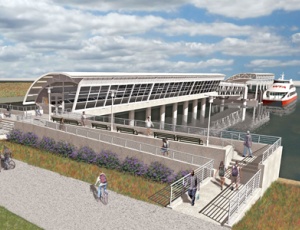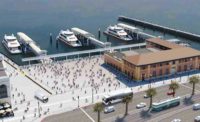The project team�s task at the South San Francisco Ferry Terminal project at Oyster Point Marina seemed reasonable enough:

Design and engineer a ferry terminal off the unpredictable waters of San Francisco Bay and make sure it can withstand a catastrophic earthquake while still meeting the letter of the Americans with Disabilities Act. Oh, and make sure the ferry itself is made of concrete -- and floats.
Not a problem, says Bo Jensen, vice president of Oakland-based Moffat & Nichol Engineers, one of the marine engineering firms hired by owner San Francisco Bay Area Water Emergency Transportation Authority for the terminal project.
�A concrete float is unusual for this part of the country, but there are other concrete floats out there,� Jensen says. �There are even concrete ships out there. It�s just a matter of displacing the right amount of water.�
The $26-million terminal project will provide ferry service to an anticipated 900 passengers a day to and from San Francisco and Alameda. The first phase of the project, completed in December, involved removing two Oyster Marina docks, shortening three others, and dredging the entrance channel and terminal basin to 10 ft.
The next phase will include construction of a 4,000-sq-ft terminal and a 92-ft-long, 12-ft-wide floating gangway and installing the 130-ft-long by 40-ft-wide float.
WETA was expected to select a general contractor for the design-build project at press time. Firms under consideration for the contract include Manson/Dutra Joint Venture of Seattle, Power Engineering Contractors of Alameda, and General Construction Co. of Polusbo, Wash. Already onboard are Moffat & Nichol, project architect ROMA Design Group of San Francisco and marine engineer Simpson Gumpertz & Heger of San Francisco.
�This will be the first new ferry terminal in San Francisco Bay in a long time,� says John Sindzinski, manager of planning at WETA. �It�s part of an overall program to increase water-transit service to help improve traffic and provide alternatives to driving. It�s also intended to be an important asset in the event of a natural or manmade disaster.�
WETA�s �overall program� is to triple ferry ridership in the bay from its present 4 million passengers annually to 12 million. Also driving the South San Francisco terminal project is the presence in the city of the biotech giant Genentech, which is planning to expand its current headquarters base of 2.8 million sq ft on 129 acres. It currently has about 8,000 employees, many of whom commute from other parts of the Bay Area where housing prices are cheaper.
A groundbreaking ceremony for the South San Francisco Terminal project was held in October, and work is expected to be completed by October 2011.
Sindzinski says Oyster Marina �is a sheltered marina, protected by breakwaters,� which makes working on the ferry project easier than in other parts of the Bay.
Jensen, however, says that the fast currents at the entrance to the marina can occasionally make for unpredictable seas.
Located about 8 mi south of the Bay Bridge, Oyster Point Marina/Park is a 600-berth marina offering spectacular views of the bay and city skylines. Sindzinski says the terminal project will include a public access element to take advantage of the area�s scenic gifts.
�There�ll be a viewing terrace so people can enjoy the natural beauty of the bay,� he says. �One of the regulatory agencies overseeing the project extracted that from us.�
The project is funded with grant money from Proposition 1B, a statewide ballot initiative approved by voters in 2006.
The Project TeamOwner:
Project Architect:
Marine Engineer:
Marine Engineer:
Geotechnical Engineers:
Contractor: San Francisco Bay Area Water Emergency Transportation Authority ROMA Design Group, San Francisco Moffat & Nichol, Oakland Simpson Gumpertz & Heger, San Francisco Treadwell & Rollo Inc., San Francisco Hydraulics Lund Engineering Inc., Tukwila, Wash.



Post a comment to this article
Report Abusive Comment